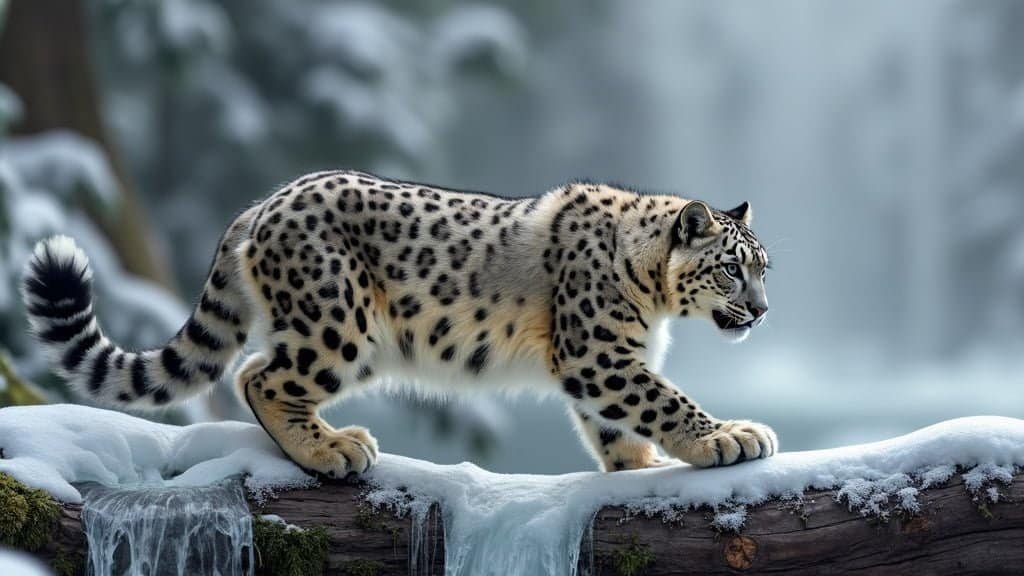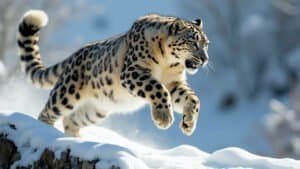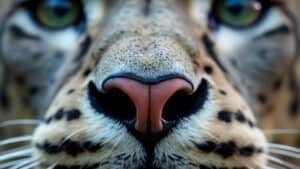When snow leopards move across icy cliffs and rocky ledges, they don’t just rely on strong legs or big paws—their tail plays a huge role too. So, how does the snow leopard’s tail function in maintaining balance? This thick, furry tail acts like a built-in stabilizer.
It helps the animal walk narrow ridges, leap across mountain gaps, and stay upright on steep slopes. In this article, you’ll explore how the tail works like a steering tool mid-air, a warm blanket in the cold, and a secret weapon for survival in the snowy highlands.
Snow Leopard Tail Adaptations for Mountain Life

High in the mountains, snow leopards face sharp cliffs, deep snow, and narrow trails. To handle this extreme terrain, their bodies have evolved in unique ways—especially their tails. The tail isn’t just for looks.
It’s long, strong, and packed with features that help the snow leopard balance, stay warm, and move smoothly. Whether leaping across a gorge or resting in the cold, the snow leopard’s tail is always working.
Tail Length and Proportions in Snow Leopards
The tail of a snow leopard is one of the longest among big cats when compared to body size. It can measure up to 41 inches, which is nearly as long as the rest of its body. This long tail gives the animal a large surface to shift weight from side to side.
When the snow leopard walks on thin, snowy paths or jumps from rock to rock, the tail moves to help keep the body steady. Without this length and mass, it would be much harder to stay balanced on mountain slopes.
Why do snow leopards have longer tails than lions or tigers? Because balance matters more when cliffs are part of your daily path.
Thick Fur and Muscle Structure of the Tail
A snow leopard’s tail is not just long—it’s thick, furry, and muscular. The dense fur keeps the tail warm and adds bulk, while the strong muscles allow it to move with control. These features turn the tail into a counterweight.
As the leopard climbs, turns, or leaps, it swings the tail to shift its center of gravity. This helps the cat stay upright and land safely. The thick fur also adds weight and stability, which is useful when running across snow or turning on icy ground.
Want to see how snow leopards control their movements with their tails? This RawrSZN article breaks it down with clear examples.
Tail as a Thermal and Energy Tool
Beyond balance, the tail also works like a blanket. In freezing weather, the snow leopard wraps its tail around its body and face to stay warm. The thick fur holds in heat and protects against icy wind.
Some scientists believe the tail may even store fat during times of plenty, giving the leopard extra energy during winter or when prey is scarce. This double use—for balance and for warmth—makes the tail one of the snow leopard’s most important tools for survival.
Ever seen a cat curl up and cover its nose with its tail? That’s not just cute—it’s smart survival in the coldest places on Earth.
Balance and Movement on Rocky Terrain

Snow leopards live in places where one wrong step could lead to a fall. Their home is filled with rocky ridges, icy cliffs, and steep slopes. To move safely, they need incredible balance—and that’s where their tail comes in.
With every step, turn, and leap, the snow leopard’s tail adjusts to keep it steady. This section shows how the tail helps the cat stay upright, even in the most dangerous spots.
How the Tail Aids Balance on Steep Slopes
When the snow leopard climbs or descends a steep mountain path, its body shifts with every step. The tail acts like a moving counterweight. It swings to the side or behind to keep the center of gravity aligned with the body’s base.
This helps the leopard avoid tipping over when standing on slanted or narrow surfaces. The tail’s mass and flexibility make it easier to walk across uneven, sloping ground without falling.
Have you ever balanced on a log and stretched your arms out? That’s what the snow leopard does—with its tail.
Using the Tail During Narrow Ridge Walks
Snow leopards often travel along thin ridges where the space is barely wider than their body. On these paths, they stretch their tail outward, just like a tightrope walker uses a balance pole. This action helps distribute weight and provides better control over each step.
If a paw slips slightly, the tail can shift to correct the movement and keep the body from falling off balance. It’s this constant adjustment that lets the cat move safely where few animals dare go.
Walking a snow-covered ridge in high wind? A snow leopard’s tail helps it stay cool, calm, and balanced.
The Tail’s Role in Agile Climbing and Turning
Climbing sharp, rocky slopes requires not just strength but control. As the snow leopard scales a cliff, the tail moves with the body to maintain balance. When the cat jumps onto a ledge or turns quickly, the tail swings to counteract the movement.
This prevents the body from spinning too much and helps land each step with precision. The tail’s movement is so finely tuned that it seems to react instantly, helping the cat remain stable even in rapid climbs or sharp turns.
Curious how keepers track tail movements to study cat health and motion? The CMZoo article shows how a tail does more than balance.
The Tail’s Function During Jumps and Landings

Snow leopards are known for their powerful jumps. In fact, they can leap up to 30 feet in a single bound—almost the length of a school bus. But jumping across a cliff or down a rocky slope takes more than strong legs.
It takes control in the air and a safe landing. That’s where the tail makes all the difference. Acting like a rudder and a stabilizer, the snow leopard’s tail helps guide and protect the body during these daring leaps.
Steering and Mid-Air Corrections
When the snow leopard jumps from one ledge to another, its tail stretches out behind the body. As it flies through the air, the tail shifts slightly from side to side to control balance and rotation. This mid-air steering helps the leopard aim its body correctly toward the landing spot.
Even small tail movements can help keep the leap straight and stable. Without this kind of control, landing could be dangerous—especially on narrow or uneven ground.
Can you imagine jumping across a gap and steering mid-air? That’s what snow leopards do—with just their tail.
Stabilizing Impact on Rocky Ground
Landing on snow-covered rocks or sharp ledges isn’t easy. A rough landing could cause slipping or injury. The snow leopard’s tail acts like a shock absorber. It shifts during the landing to balance the body and soften the impact.
The thick, heavy tail helps control the angle of descent so the leopard lands with all four paws firmly planted. This balance and support allow the animal to leap more often and more safely, even across dangerous terrain.
Why doesn’t the snow leopard fall after such long jumps? Its tail keeps each landing smooth and stable.
Comparison to Other Big Cats’ Jumping Techniques
While all big cats use their tails for some balance, snow leopards rely on theirs much more. A lion or tiger may use its tail for turning or swatting, but they don’t often jump across cliffs.
The snow leopard’s long, thick tail gives it more control in the air and helps it land in places that would challenge any other cat. Its tail isn’t just longer—it’s built for life in the air and on the edge.
Want more facts on how tails help cats move? Check out Animalia.bio for details on snow leopard adaptations.
Multi-Purpose Uses of the Snow Leopard’s Tail

While the snow leopard’s tail is best known for balance, it does much more than help with movement. This long, thick appendage is a multi-use tool that supports the animal in many ways—especially in cold, high-altitude environments.
From keeping warm to storing energy, the snow leopard’s tail is a key part of its survival strategy. In this section, you’ll see how this single body part plays many different roles, both active and passive.
How the Tail Helps Retain Heat
In freezing mountain climates, snow leopards need to keep their body heat from escaping. Their tail acts like a built-in scarf. When resting, the snow leopard curls up and wraps its tail around its face and nose. The thick fur traps warmth and shields against cold air and snow.
This behavior is often seen when the cat is lying still on ice or resting in open terrain where windchill is high. By protecting its face and paws, the tail helps prevent heat loss in the body’s most exposed areas.
Imagine using your tail as a blanket on a snowy mountain—that’s smart survival.
Protective Wrapping Around the Face and Paws
Besides keeping the face warm, the tail also wraps around the feet and even the belly in cold weather. The paws are one of the most vulnerable parts of any animal in snow. By covering them with its thick tail, the snow leopard reduces the risk of frostbite and keeps muscles flexible.
It’s not just comfort—it’s protection. This self-wrapping behavior is rarely seen in other big cats because their tails are not as long or as fur-covered.
Could a tail be your winter coat and your heating pad? For a snow leopard, the answer is yes.
The Tail as a Sign of Evolutionary Advantage
Everything about the snow leopard’s tail—its length, fur, flexibility, and strength—shows how well it has adapted to life in the mountains. Over time, these traits have helped the species thrive in cold, rough landscapes where few other predators can hunt.
The tail gives the snow leopard more control, warmth, and energy balance than other big cats. In fact, researchers often look at tail health and size as signs of overall health and adaptation in snow leopards.
Evolution gave this mountain cat the perfect tail—not just for balance, but for life on the edge.













